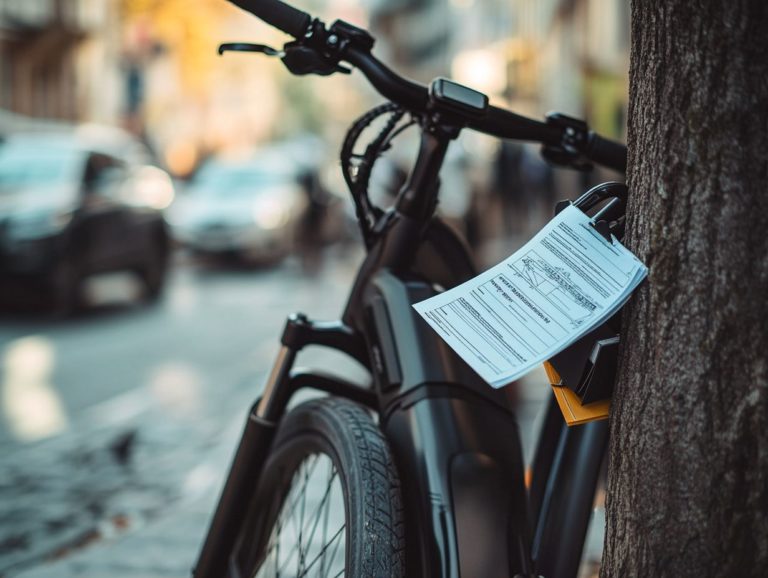Electric Bicycle Helmet Law: A State-by-State Guide
Electric bicycle usage is increasingly popular, introducing a range of safety considerations, particularly regarding helmet laws. This guide meticulously examines electric bicycle helmet laws throughout the United States. Get ready to explore the spectrum of regulations, from states enforcing strict mandatory helmet requirements to those with no laws in place. Each approach carries its own nuances that deserve your attention.
This guide also covers common exemptions, penalties for non-compliance, and the ongoing discussion about helmet safety. Equip yourself with the knowledge needed to navigate these regulations and understand their implications as a rider. Stay safe and informed know your local laws!
Contents
- Key Takeaways:
- 2. States with Mandatory Helmet Laws
- 3. States with Partial Helmet Laws
- 4. States with No Helmet Laws
- 5. Understanding the Differences between Mandatory and Partial Helmet Laws
- 6. Common Exemptions to Helmet Laws
- 7. Penalties for Not Wearing a Helmet
- 8. Arguments for and Against Helmet Laws
- 9. Impact of Helmet Laws on Electric Bicycle Usage
- 10. How to Choose the Right Helmet for Your Electric Bicycle
- 11. Tips for Safe Riding with or without a Helmet
- 12. How to Advocate for Changes to Helmet Laws in Your State
- 13. Future of Electric Bicycle Helmet Laws
- What Are the Most Common Electric Bicycle Helmet Laws in the US?
- Frequently Asked Questions
- What is an Electric Bicycle Helmet Law?
- Do all states have an Electric Bicycle Helmet Law?
- Which states have an Electric Bicycle Helmet Law?
- What is the penalty for not wearing a helmet while riding an electric bicycle in states with an Electric Bicycle Helmet Law?
- Are there any exemptions to the Electric Bicycle Helmet Law under state regulations?
- Is it important to wear a helmet while riding an electric bicycle, considering the legal environment and state-specific regulations even in states without an Electric Bicycle Helmet Law?
Key Takeaways:

- Wearing a helmet while riding an electric bicycle is mandatory in some states and optional in others.
- The benefits of wearing a helmet include reduced risk of head injuries and increased safety while riding.
- States can improve their helmet laws by implementing mandatory laws and addressing common exemptions.
2. States with Mandatory Helmet Laws
Several states have taken the initiative to enforce mandatory helmet laws for electric bicycle riders, underscoring the importance of safety for e-bike enthusiasts across the nation. These laws vary widely; for instance, states like California and New York require all riders, regardless of age, to don helmets. In contrast, states such as Ohio and Florida only require helmets for riders under 16, resulting in a confusing patchwork of regulations for e-bike users.
The implications of these laws are significant; failing to comply could lead to fines or even restrictions on where you can ride. Enforcement practices also differ considerably from state to state some impose strict penalties while others focus on education over punishment. To navigate these legal waters effectively, it s essential for riders to understand the specific e-bike laws in their respective states.
3. States with Partial Helmet Laws
In some states, you ll find partial helmet laws in place, meaning only certain categories of e-bike riders like younger individuals or those on specific bike paths are mandated to wear helmets. These regulations can vary significantly from one state to another, creating a confusing patchwork of compliance requirements for e-bike users.
For example, in states like California and Florida, individuals below a certain age are required to wear helmets, while adults might enjoy the freedom of riding without one under specific conditions. Some trails may even implement their own helmet regulations, adding another layer of complexity for riders who may not be aware of local ordinances. This uneven landscape not only poses potential safety risks but also sparks questions about liability and responsibility as riders navigate the differing laws while attempting to relish their rides.
4. States with No Helmet Laws
A number of states have chosen to implement no helmet laws for e-bike riders, creating an environment where you can enjoy the ride without the obligation of mandatory headgear. This decision often reflects a belief in personal freedom and individual responsibility, allowing you to determine which safety measures align with your preferences.
In states like Arizona, New Jersey, and Florida, the reasoning typically revolves around the desire to promote cycling and attract tourism, viewing e-bikes as a green alternative for transportation. However, the absence of a helmet mandate does raise valid concerns about potential risks, such as an increase in head injuries during accidents.
Some argue that riding without a helmet may encourage more people to embrace e-bikes, thereby nurturing a healthier, eco-friendly culture in urban environments. It s crucial for you to stay informed about specific local ordinances that may still advocate or require protective gear in certain areas, ensuring your safety while navigating diverse terrains.
5. Understanding the Differences between Mandatory and Partial Helmet Laws
Understanding the differences between mandatory and partial helmet laws is crucial for e-bike riders. These distinctions can significantly impact your safety and the rules you need to follow on the road.
Different states have their own regulations, which can complicate matters. For instance, California enforces a strict mandatory helmet law for all cyclists, including e-bike riders. Everyone must wear a helmet, regardless of age.
On the other hand, Florida’s partial helmet law only requires those under 16 to wear helmets, leaving older riders to make their own choices. These differences often confuse riders, especially those who travel between states.
These differences affect rider safety and local laws. It s essential for you to stay informed about your local laws to avoid hefty fines or, even worse, unsafe riding conditions.
6. Common Exemptions to Helmet Laws
Many helmet laws feature common exemptions that allow certain e-bike riders to skip helmet usage. This may include riders over a particular age or those riding in designated areas.
These regulations can vary widely from state to state. In some locations, riders over 18 may be free from helmet requirements, while others might allow exceptions for those cruising along bike lanes or specific recreational trails.
This creates a mixed bag for e-bike enthusiasts. Understanding the local laws is essential for both safety and compliance. Exemptions may also account for different types of e-bikes, further complicating the landscape.
For those who fit these criteria, this can lead to a more liberating riding experience without the burden of extra gear. Always prioritize your safety it’s key to enjoying your ride!
7. Penalties for Not Wearing a Helmet

Failing to comply with helmet laws can result in serious penalties! E-bike riders may face fines and possible legal issues that complicate your ride.
In various states, the severity of these penalties can vary significantly. Some jurisdictions might slap you with a mere nominal fine, while others could escalate matters to more serious consequences, such as points on your driving record or even mandatory court appearances.
Enforcement practices also differ widely. In some areas, you might find strict monitoring and ticketing, whereas others adopt a more relaxed approach.
For those who choose not to wear helmets, the stakes rise considerably. These penalties can create increased financial burdens and potential liabilities in the event of an accident.
Not wearing appropriate safety gear may not only be seen unfavorably in insurance assessments but could also complicate any legal claims you might face.
8. Arguments for and Against Helmet Laws
The debate surrounding helmet laws for e-bikes presents a multifaceted discussion, showcasing a variety of perspectives on safety and personal freedom among riders.
On one side, proponents of helmet laws argue that wearing protective gear can significantly reduce the risk of head injuries. This is especially important in the rapidly expanding e-bike community that frequently navigates urban landscapes.
They point out that, much like seatbelt laws for cars, helmet regulations could foster a culture of safety, potentially leading to fewer injuries and fatalities.
On the flip side, critics assert that enforcing such laws could encroach on individual freedom, suggesting that riders should be given the power to determine their own safety measures.
Some also express concerns that mandatory helmet laws might dissuade newcomers from exploring e-biking, thus hindering the growth of an environmentally friendly transportation alternative.
9. Impact of Helmet Laws on Electric Bicycle Usage
Helmet laws significantly impact your experience with electric bicycles, influencing how many riders like you embrace this eco-friendly mode of transportation.
In states where wearing a helmet is mandatory, studies reveal a noticeable dip in e-bike adoption rates compared to regions with more relaxed regulations. For instance, in California, where helmets are required, only about 10% of e-bike users report consistent use. Meanwhile, states like Oregon, with less stringent laws, enjoy an impressive 30% adoption rate. To understand the different regulations, including age restrictions, check out this guide on electric bicycle age restrictions by state.
This variation shows that helmet regulations shape individual choices and play a pivotal role in the broader cultural acceptance of e-bikes as a sustainable commuting option. As you make your decisions, the interplay between safety measures and personal freedom becomes evident, sparking discussions about how to balance protection with accessibility within the cycling community.
10. How to Choose the Right Helmet for Your Electric Bicycle
Selecting the right helmet for your electric bicycle is essential for both safety and comfort. There are several factors to consider based on your preferences and riding conditions.
The fit of the helmet should be snug yet comfortable, ensuring it stays in place while allowing for adequate ventilation. Prioritize peace of mind by paying attention to safety ratings from reputable organizations; these ratings indicate how well the helmet withstands impacts.
Visibility is equally important. Opt for bright colors or reflective materials that enhance your presence on the road. Consider your typical riding environment when making a choice.
Investing in features such as a lightweight design or integrated lights can significantly enhance your safety during nighttime rides.
11. Tips for Safe Riding with or without a Helmet
Regardless of helmet laws, practicing safe riding techniques is essential for you as an e-bike rider. This ensures a safer experience on bike paths and roadways.
Stay aware of your surroundings by regularly checking for pedestrians, vehicles, and other cyclists to anticipate potential hazards. Clear hand gestures are important for signaling your intentions to others, which reduces the risk of accidents.
Familiarize yourself with local ordinances regarding e-biking, including speed limits and designated areas for e-bikes. These regulations can vary significantly. By prioritizing these practices, you contribute to a safer riding environment and enjoy your journey with peace of mind.
12. How to Advocate for Changes to Helmet Laws in Your State
Advocating for changes to helmet laws in your state requires a strategic approach within the e-bike community. Leveraging support from organizations like PeopleForBikes can amplify your voice.
Start by building community support through local events and educational workshops that showcase the benefits of safer e-bike regulations. Engaging with fellow e-bike enthusiasts creates a unified front, making it easier to raise awareness collectively.
Reaching out to local representatives is crucial. Thoughtful letters or scheduled meetings can spark meaningful discussions about the potential for new regulations. Utilize social media platforms to share your stories, gather momentum, and connect with a broader audience, further solidifying your case for change.
Now is the time to make your voice heard! Join the e-bike movement for a cleaner future!
13. Future of Electric Bicycle Helmet Laws

The future of electric bicycle helmet laws is uncertain, influenced by changing trends in e-bike usage and advocacy efforts from organizations like PeopleForBikes that are shaping the legal landscape.
As more people embrace electric bicycles for commuting, recreation, and fitness, discussions about safety regulations are becoming increasingly important. This surge in popularity may prompt lawmakers to reevaluate existing helmet requirements, especially in urban areas where e-bikes are becoming a sustainable alternative to cars. For those interested in understanding the legal landscape, navigating electric bicycle licensing requirements will be crucial.
Advocates suggest that promoting safe riding practices can go hand in hand with increasing accessibility. This could lead to more community-based educational initiatives. Ultimately, as cities adapt to this innovative mode of transportation, the balance between staying safe and enjoying your ride will likely shape future regulations.
What Are the Most Common Electric Bicycle Helmet Laws in the US?
Understanding the most common electric bicycle helmet laws in the US is essential for e-bike riders like you, as these regulations can vary significantly from state to state.
This patchwork of laws means that what’s acceptable in one state may not be in another, creating rules that make it hard to follow the law while riding. For a clearer understanding of the varying regulations, refer to the electric bicycle regulations: a global overview. Some states require helmet use for all riders, regardless of age, while others have specific rules that apply only to younger riders or certain types of electric bicycles.
There may also be variations in helmet safety standards and whether riders can opt out if they are of legal age. Make sure you know your local laws, including the top 5 electric bicycle laws, before you ride, ensuring both your safety and legal compliance.
What Are the Benefits of Wearing a Helmet While Riding an Electric Bicycle?
Wearing a helmet while riding an electric bicycle offers numerous benefits, primarily enhancing your safety and significantly reducing the risk of head injuries in an accident.
Studies show that simply putting on a helmet can cut the risk of head injuries by over 50%, highlighting why this straightforward yet impactful safety measure is essential. The statistics are compelling: cyclists without helmets face a much higher likelihood of severe head trauma, with nearly 75% of fatal cycling accidents occurring among those who ride unprotected.
For anyone who enjoys the thrill of e-biking, wearing a helmet not only provides vital physical protection but also fosters a sense of confidence and tranquility. This allows you to fully enjoy the ride without worrying about potential hazards.
What Are the Safety Concerns for Electric Bicycle Riders?
As an electric bicycle rider, you face distinct safety concerns, particularly the risk of high-speed accidents and dangerous interactions in traffic that can lead to serious injuries.
Factors such as poor road conditions, like potholes and uneven surfaces, significantly increase your risks. You often navigate bustling streets where motor vehicles may overlook your presence, resulting in dangerously close encounters. Interactions with cars, especially during lane changes and at intersections, are particularly critical, as a lack of awareness can lead to devastating consequences.
In this environment, enforced helmet laws are vital, providing a crucial layer of protection that can help lessen the severity of injuries if an accident occurs.
Have you checked your local helmet laws lately? Remember, wearing a helmet is not just smart; it’s essential for your safety! Share your riding tips or experiences to foster community interaction!
How Can States Improve Helmet Laws for Electric Bicycle Riders?
States can enhance helmet laws for electric bicycle riders by adopting proven methods that prioritize safety and cater to the needs of e-bike lovers.
Establishing clear guidelines that distinguish between different classes of e-bikes such as those for commuting, recreational riding, or off-road adventures is an effective strategy. This differentiation helps ensure legislation aligns with the speed capabilities and intended use of each type, ultimately promoting safer riding practices.
Boosting public awareness campaigns is crucial for educating both riders and motorists on the significance of proper helmet usage and the importance of sharing the road. These initiatives cultivate a culture of safety and empower e-bike riders to make informed decisions about their protection while navigating the streets.
What Are the Helmet Laws for Electric Bicycle Riders in Other Countries?
Examining helmet laws for electric bicycle riders in other countries provides valuable insights into diverse regulatory approaches and their effectiveness in promoting rider safety.
Countries like the Netherlands and Germany emphasize education and infrastructure support alongside mandatory helmet use, fostering a culture of cycling where safety is integrated into daily life.
In contrast, the U.S. adopts a more fragmented approach, with helmet laws varying significantly across states. This leads to inconsistencies in compliance and enforcement, which can be quite perplexing.
Meanwhile, countries like Australia have strict helmet requirements but balance these regulations with incentives for e-bike use, showcasing an emerging trend to adapt to new forms of mobility.
Understanding these differences reveals how we can improve safety for everyone, encouraging exploration of best practices that could inform future U.S. policies.
Frequently Asked Questions

What is an Electric Bicycle Helmet Law?
An Electric Bicycle Helmet Law requires riders to wear a helmet for safety.
Do all states have an Electric Bicycle Helmet Law?
No, not all states have an Electric Bicycle Helmet Law. Each state has its own regulations regarding electric bicycles, including helmet laws.
Which states have an Electric Bicycle Helmet Law?
As of 2021, 23 states and the District of Columbia have an Electric Bicycle Helmet Law. These include California, New York, and Florida.
What is the penalty for not wearing a helmet while riding an electric bicycle in states with an Electric Bicycle Helmet Law?
The penalty varies by state. Some states may issue a fine, while others may require the individual to complete a safety course.
Are there any exemptions to the Electric Bicycle Helmet Law under state regulations?
Yes, some states like Alabama, Alaska, and Arizona have exemptions. These may include age restrictions or certain types of electric bicycles, like Class 1 and Class 2 e-bikes, which may not require a helmet.
Is it important to wear a helmet while riding an electric bicycle, considering the legal environment and state-specific regulations even in states without an Electric Bicycle Helmet Law?
Yes, wearing a helmet is crucial for health and fitness reasons, even in states without an Electric Bicycle Helmet Law. The risk of head injuries increases when riding Class 3 e-bikes, which have higher speeds and require extra caution.
Stay safe and informed check your local regulations today!





